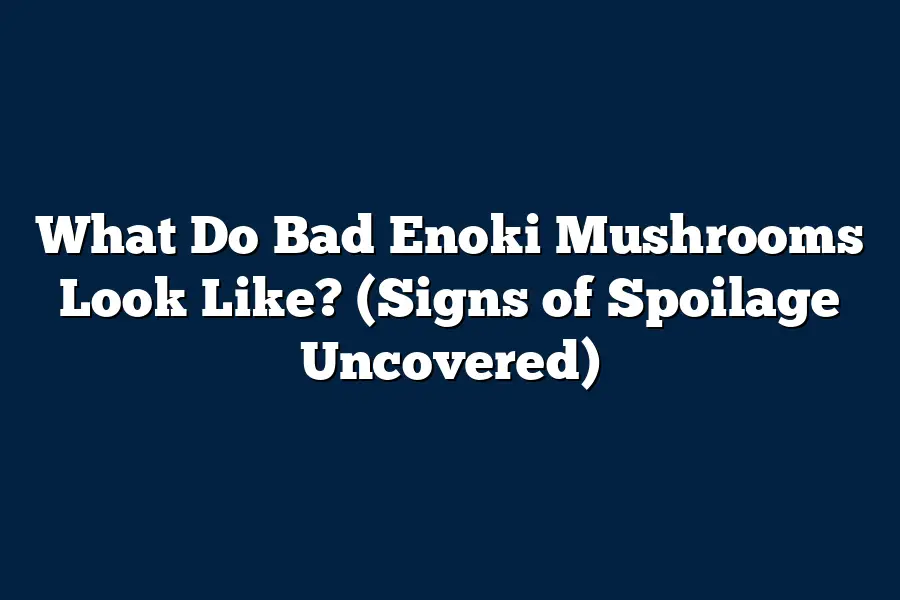Bad enoki mushrooms will appear slimy, discolored, or have a strong odor. The stems may become mushy, and the caps may darken in color. Additionally, mold growth on the mushrooms is a clear indicator that they have spoiled and should be discarded immediately.
Calling all fungi fans!
Ever puzzled over if your enoki mushrooms are still good to go?
Dive into our guide to spot spoilage signs and master the art of identifying fresh vs.
bad enoki mushrooms.
Let’s unravel the mystery together!
🍄
Table of Contents
Understanding Enoki Mushrooms – A Brief Overview
When it comes to identifying bad enoki mushrooms, it’s crucial to have a good understanding of what these mushrooms should look like in their optimal state.
In this section, we will delve into the key characteristics of enoki mushrooms to help you differentiate between good and bad ones.
Appearance
Enoki mushrooms, also known as golden needle mushrooms, are recognized for their long, thin stems and petite, rounded caps.
Typically, these mushrooms have a crisp texture and a slightly fruity aroma.
When fresh, enoki mushrooms should appear bright white in color, with firm stems and caps free of any discoloration or sliminess.
Texture
One of the defining features of enoki mushrooms is their unique texture.
Good enoki mushrooms should have a crunchy bite, similar to bean sprouts.
If you notice any mushiness or sliminess when handling the mushrooms, it’s a clear sign that they may have gone bad.
Smell
Fresh enoki mushrooms emit a subtle, earthy fragrance that is slightly sweet.
On the other hand, bad enoki mushrooms may have a strong, unpleasant odor resembling ammonia or mold.
Trust your sense of smell to determine if the mushrooms are past their prime.
Storage
Proper storage is essential for maintaining the quality of enoki mushrooms.
These delicate fungi are best kept in the refrigerator, preferably in a paper bag or breathable container to prevent moisture buildup.
Storing enoki mushrooms in airtight packaging can cause them to deteriorate quickly.
Sources and Recommendations
According to the USDA’s guidelines for fresh produce storage, enoki mushrooms should be refrigerated at temperatures between 34-38°F (1-3°C) to prolong their shelf life.
It’s crucial to consume enoki mushrooms within a few days of purchase for the best taste and texture.
In a study conducted by the Journal of Food Protection, researchers found that improper storage conditions can lead to the growth of harmful bacteria on enoki mushrooms, posing a risk to consumers.
By following proper storage practices, you can minimize the chances of encountering bad enoki mushrooms.
By familiarizing yourself with the appearance, texture, smell, and storage recommendations for enoki mushrooms, you’ll be better equipped to distinguish between fresh, high-quality mushrooms and those past their prime.
Stay vigilant and trust your senses to enjoy the delightful taste and texture of enoki mushrooms in your culinary creations.
Visual Indicators of Spoiled Enoki Mushrooms
Have you ever reached for a pack of enoki mushrooms at the grocery store, only to discover they have gone bad once you’re home?
It can be frustrating and disappointing.
But fear not!
By familiarizing yourself with the visual indicators of spoiled enoki mushrooms, you can avoid this culinary letdown and ensure your dishes are always top-notch.
1. Sliminess
One of the most common visual indicators of spoiled enoki mushrooms is sliminess.
When fresh, enoki mushrooms have a firm, dry texture.
However, if you notice a slimy or slippery film on the mushrooms, it’s a clear sign that they have started to spoil.
This sliminess is due to the growth of bacteria or mold on the surface of the mushrooms, indicating that they are past their prime.
2. Discoloration
Another telltale sign of spoiled enoki mushrooms is discoloration.
Fresh enoki mushrooms are bright white from top to bottom.
If you spot any brown, yellow, or dark spots on the mushrooms, it’s a sign that they have begun to deteriorate.
Discoloration is a result of oxidation or the growth of mold, both of which compromise the quality and flavor of the mushrooms.
3. Unpleasant Odor
Fresh enoki mushrooms have a mild, earthy aroma that is characteristic of most mushrooms.
However, when enoki mushrooms start to spoil, they emit a pungent and unpleasant odor.
If you detect any off-putting smells when you open the package, it’s a strong indication that the mushrooms are no longer fit for consumption.
4. Slimy Stems
Inspect the stems of the enoki mushrooms closely.
While fresh enoki mushrooms have crisp and firm stems, spoiled mushrooms develop slimy and mushy stems.
If the stems feel slimy to the touch or appear to be disintegrating, it’s a clear sign that the mushrooms are no longer fresh and should be discarded.
5. Wrinkled Caps
Lastly, pay attention to the caps of the enoki mushrooms.
Fresh enoki mushrooms have smooth, taut caps that are tightly closed.
On the other hand, spoiled mushrooms develop wrinkled and shriveled caps as they lose moisture and degrade.
If you notice any signs of wrinkling or shriveling on the mushroom caps, it’s time to bid farewell to those enoki mushrooms.
By keeping an eye out for these visual indicators of spoiled enoki mushrooms, you can ensure that your culinary creations are always made with the freshest and highest quality ingredients.
Remember, when in doubt, it’s better to err on the side of caution and opt for fresh mushrooms to elevate your dishes to the next level!
Importance of Proper Storage to Prevent Spoilage
As a mushroom enthusiast, nothing is more disheartening than discovering that your fresh enoki mushrooms have gone bad.
However, fret not, as proper storage can significantly extend the shelf life of these delicate fungi.
Let’s dive into the importance of storing enoki mushrooms correctly to prevent spoilage.
Why Proper Storage Matters
Ensuring that your enoki mushrooms are stored correctly is crucial for maintaining their quality and taste.
Improper storage can lead to premature spoilage, resulting in slimy, discolored, or mushy mushrooms that are no longer suitable for consumption.
By following the right storage practices, you can prolong the freshness of your enoki mushrooms and enjoy them at their best.
Ideal Storage Conditions
Temperature Control: Enoki mushrooms thrive in cool temperatures. Store them in the refrigerator between 32-36°F (0-2°C) to slow down the growth of bacteria and preserve their texture.
Humidity Levels: Enoki mushrooms prefer a humid environment. Keep them in a breathable container or perforated plastic bag to maintain moisture levels without allowing them to become damp.
Avoid Moisture: Excess moisture can cause enoki mushrooms to become slimy and prone to mold growth. Ensure they are not stored in a damp or wet environment to prevent spoilage.
Preventing Cross-Contamination
Separate Storage: To prevent cross-contamination and extend the shelf life of your enoki mushrooms, store them separately from strong-smelling foods like onions, garlic, or fish.
Use Airtight Containers: If storing in the refrigerator, place your enoki mushrooms in an airtight container to protect them from absorbing odors from other foods.
Extending Shelf Life
By adopting proper storage practices, you can maximize the freshness of your enoki mushrooms and reduce food waste.
With these simple steps, you can savor the impeccable taste and texture of enoki mushrooms in your culinary creations for longer periods.
paying attention to the storage of your enoki mushrooms is essential in preserving their quality and preventing spoilage.
By maintaining ideal storage conditions, preventing cross-contamination, and extending their shelf life, you can enjoy these delicate mushrooms at their peak freshness.
Stay tuned for more tips on handling and cooking enoki mushrooms to elevate your culinary experience!
How to Tell if Your Enoki Mushrooms Have Gone Bad
Are you unsure whether your enoki mushrooms are still safe to eat?
Let’s break down how you can differentiate between fresh enoki mushrooms and those that have spoiled.
Visual Inspection
The first step in determining the quality of your enoki mushrooms is through a visual examination.
Here’s what to look out for:
- Color: Fresh enoki mushrooms have a bright white color, while spoiled ones may appear darker or have brown spots.
- Texture: Feel the mushrooms – fresh enoki mushrooms should be firm and moist, while spoiled ones may feel slimy or mushy.
- Visual Mold: Check for any visible signs of mold growth on the mushrooms. Mold is a clear indicator that the enoki mushrooms have gone bad.
Smell Test
Your sense of smell can also provide valuable information about the freshness of enoki mushrooms.
Take a whiff and pay attention to the aroma:
- Freshness: Fresh enoki mushrooms should have a mild, earthy smell.
- Spoilage: If the mushrooms emit a strong, unpleasant odor, it’s a sign that they have spoiled.
Expiration Date
Always check the expiration date on the packaging of your enoki mushrooms.
Consuming mushrooms past their expiration date significantly increases the risk of foodborne illness.
Storage Conditions
Proper storage is crucial in maintaining the freshness of enoki mushrooms.
- Refrigeration: Store enoki mushrooms in the refrigerator to prolong their shelf life. Keep them in a paper bag or a breathable container to prevent moisture buildup.
- Avoid Moisture: Excess moisture can cause enoki mushrooms to spoil quickly. Ensure they are not stored in a damp environment.
- Air Circulation: Allow for proper air circulation around the mushrooms to prevent them from becoming soggy.
By following these guidelines, you can ensure that you are consuming fresh and safe enoki mushrooms.
Remember, when in doubt, it’s best to err on the side of caution and discard any mushrooms that show signs of spoilage.
Stay tuned for more tips on handling and storing fresh produce!
Final Thoughts
Being able to identify the signs of spoilage in enoki mushrooms is crucial for ensuring food safety.
By recognizing visual indicators like discoloration, sliminess, and a foul odor, you can protect yourself from consuming bad mushrooms that could lead to foodborne illnesses.
Remember, proper storage practices play a key role in preserving the freshness of your enoki mushrooms.
Take the time to inspect them before use, and trust your senses to differentiate between what’s fresh and what’s spoiled.
Stay safe, stay informed, and enjoy your enoki mushrooms worry-free!
Next time you’re at the store or in your kitchen, use these tips to make sure your enoki mushrooms are in their prime.
Happy cooking!

